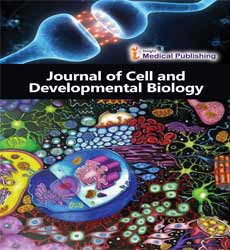Cell Communication: A brief note
Rahul K Khera*
Department of Molecular Biology, Manipal University (MAHE)- Manipal Academy of Higher Education, Manipal, Karnataka
- *Corresponding Author:
- Rahul K Khera
Department of Molecular Biology, Manipal University (MAHE)- Manipal Academy of Higher Education, Manipal, Karnataka
E-mail: kherarahul00@gmail.com
Received Date: September 01, 2021; Accepted Date: September 15, 2021; Published Date: September 24, 2021
Citation: Khera RK (2021) Cell Communication: A Brief Note. J Cell Dev Biol. Vol.5 No.5:12.
Perspective
The study of cell communication focuses on how a cell gives and receives messages with its environment and with itself. Indeed, cells don't sleep in isolation. Their survival depends on receiving and processing information from the surface environment, whether that information pertains to the supply of nutrients, changes in temperature, or variations in light levels. Cells also can communicate directly with each other — and alter their own internal workings in response — by way of a spread of chemical and mechanical signals. In multicellular organisms, cell signaling allows for specialization of groups of cells. Multiple cell types can then join together to make tissues like muscle, blood, and brain tissue. In single-celled organisms, signaling allows populations of cells to coordinate with each other and work sort of a team to accomplish tasks no single cell could perform on its own.The study of cell signaling touches multiple biological disciplines, like developmental biology, neurobiology, and endocrinology. Consequently, the relevance of cell communication is sort of vast, but major areas of fundamental research are often divided between the study of signals at the cell wall and therefore the study of signals within and between intracellular compartments. Membrane signaling involves proteins shaped into receptors embedded within the cell's membrane that biophysically connect the triggers within the external environment to the continued dynamic chemistry inside a cell. Signaling at the membrane also involves ion channels, which permit the direct passage of molecules between external and internal compartments of the cell. Scientists ask: what's the receptor structure that permits it to react to an external signal.
Cells have evolved a spread of signaling mechanisms to accomplish the transmission of important biological information. Some samples of this variety are receptors that allow ion currents to flow in response to photons, which effectively translates light into chemical messengers inside the cone and rod cells of the retina; growth factors that interact with the cell wall and may trigger receptors that powerfully affect chromatin structure and therefore the modulation of gene expression; metabolites within the blood which will trigger a cell's receptors to cause the discharge of a hormone needed for glucose regulation; adhesion receptors which will convey tension-generated forces that direct a cell to remain put or change direction of movement; and developmentally regulated receptors which will strictly guide the trail of a migrating cell, ultimately controlling how a whole organism is wired together.
One method is reductionist, whereby cells are isolated and cultured in vitro in order that specific signals are often carefully tested chemically and cellular responses are often measured. Another more holistic method involves measuring cellular signaling during a n intact organism (in vivo) by applying specific chemical agents that block or activate receptors in a carefully chosen tissue region then measuring the response via an electrode that relays the activity of ion currents or via fluid sampling of the activated area. For both approaches, response measurement is vitally important, and measuring the tiny cellular entities is indeed a challenge. Scientists use sophisticated timelapse microscopy to trace labeled molecules that travel between subcellular compartments after a signaling event or to trace the conformation of a receptor that has gone from an inactive to a lively state. Furthermore, mass spectrometry techniques permit measurements of picomolar amounts, enabling the tracking of intracellular second messenger molecules that are crucial within the regulation of signals within the intracellular milieu.
Despite technical advances, global understanding of signal transduction, its internal hierarchies, and its highly integrated and very dynamic nature remains largely mysterious. possible breakthrough within the field arose recently when scientists realized that there are striking analogies between signaling networks in biological systems and electronic circuits; both of them involve hierarchies, switches, modularity, redundancy, and therefore the existence of powerful feedback mechanisms. Such a realization gave impetus to the sector of computational biology as applied to cellular signaling. Today, the study of cell signaling isn't restricted to biologists; with the contribution of engineers and biophysicists, scientists can now create computational algorithms that model the structure of a signaling network supported biological measurements, and these models are often wont to predict the result of otherwise physically impossible experimental conditions. because it seems , we are just starting to appreciate that a lot of the designs and methods we've developed to control information, particularly within the digital world, are literally present in biological networks, having already been invented over the course of 100 million years of evolution.
Open Access Journals
- Aquaculture & Veterinary Science
- Chemistry & Chemical Sciences
- Clinical Sciences
- Engineering
- General Science
- Genetics & Molecular Biology
- Health Care & Nursing
- Immunology & Microbiology
- Materials Science
- Mathematics & Physics
- Medical Sciences
- Neurology & Psychiatry
- Oncology & Cancer Science
- Pharmaceutical Sciences
